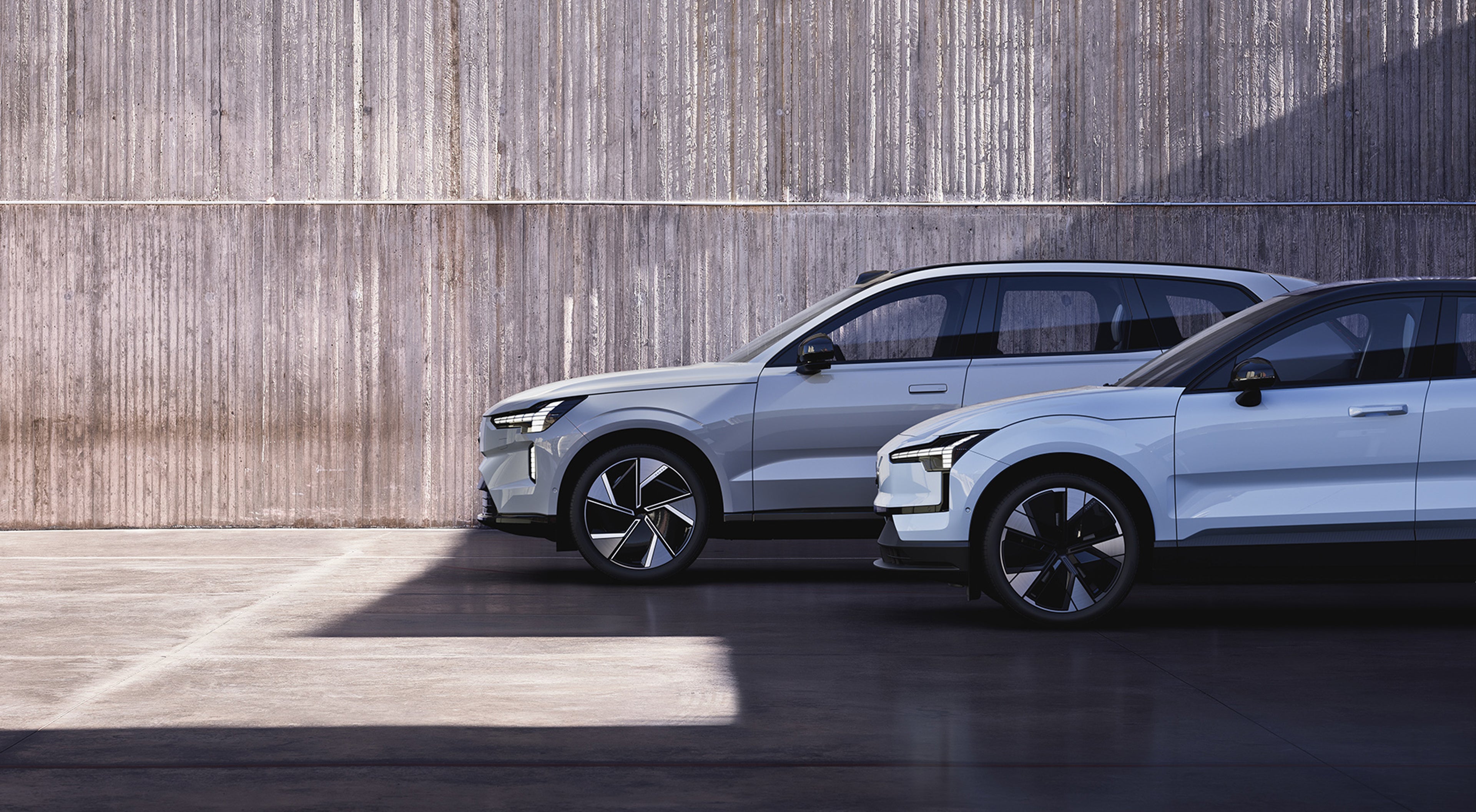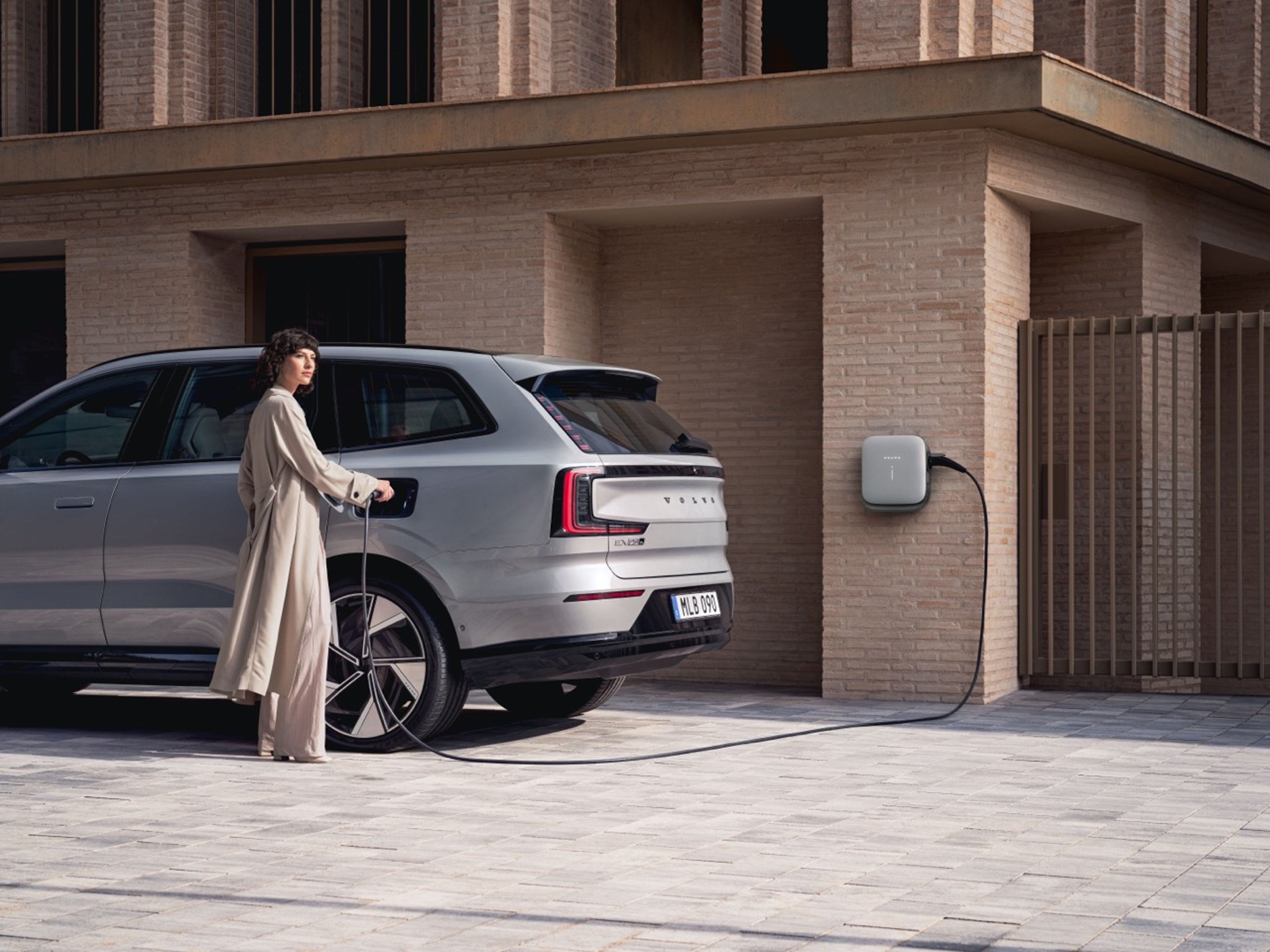
Helpful tips to consider in achieving a smaller carbon footprint for your company car fleet.
Discover FleetStory
What to consider when developing a more sustainable company car policy to achieve a smaller environmental footprint? Here's a helping guide for achieving the ambitions for your fleet.
Fleet
EX90

Helpful tips to consider in achieving a smaller carbon footprint for your company car fleet.
Discover FleetYour current carbon footprint
In order to reduce the carbon emissions from your fleet you will first need to measure your current footprint. What are the CO₂ emissions of your vehicles over
the last year of operation?
To calculate the CO₂ tailpipe emissions of petrol and diesel cars, as well as for plug-in hybrid cars, take the certified fuel consumption for each vehicle in CO₂ g/km, and multiply it with the total distance in kilometres driven for the same vehicle. For plug-in hybrid cars, the CO₂ tailpipe emissions will depend on how much the car is driven in fully electric and hybrid mode, but the certified fuel consumption can be used as a fair estimate. For a fully electric car, the CO₂ tailpipe emissions will be zero.
For pure electric and plug-in hybrid cars, also remember to include emissions from producing the electricity needed to charge your company cars. To calculate this, multiply the certified energy consumption per kilometre of the car with the total kilometres driven on electricity, and with the yearly average CO₂ grams per kWh of the country the car is charged within.
Go for zero
Electric vehicles that produce zero tailpipe emissions while driving can contribute to huge CO₂ savings for your fleet. Across many parts of Europe, fossil-free electricity is available, thanks to nuclear power or renewable sources like wind and solar. When electricity comes from more polluting sources, the emissions of producing the electricity happen further up in the supply chain. But nevertheless, electric vehicles still maintain a lower overall carbon footprint than their petrol and diesel equivalents – even when using electricity generated from coal or gas.
To document the environmental impact of electric cars as transparently as possible, Volvo Cars has since 2019 published comprehensive life cycle assessments of its new electric models. These reports examine the total carbon footprint over the complete lifecycle, including which materials and processes contribute most to the vehicle’s emissions – from raw material extraction and processing to end-of-life disposal.
The latest report for Volvo EX90 shows, for example, that the car’s carbon footprint over its entire life cycle is approximately 50 percent lower than that of a Volvo XC90 mild hybrid if charged using the average European electricity mix. If, instead, the car is charged using renewable energy sources such as wind power, the EX90’s carbon footprint is reduced even further, by 17 percent compared to using the European electricity mix.

Electrify your fleet and encourage smart charging.
Power up
In addition to zero-emission vehicles in your fleet, the drivers can add to reducing the overall environmental footprint by smart charging, taking advantage of lower off-peak energy rates compared to peak times, creating demand when there is surplus of energy. Luckily, low hourly electricity prices tend to have a high correlation to low CO₂ intensity of the electricity being charged, as renewable sources are often the cheapest to produce. Charging cheap is therefore often the same as charging clean.
The new vehicle-to-grid technology is also under development. It's a true investment in the future, transforming the car's battery into a portable power plant. A car is often parked for many hours each day, even company cars. With vehicle-to-grid functionality, the car can be connected to an office or home charger, and electricity from the car battery can be used during the hours of the day when electricity prices are at their highest. This functionality allows the car to support the grid when needed, further reducing the need for high-emission and high-cost electricity production.
Plug in plug-in hybrids
Plug-in hybrid vehicles offer a low-emission bridge toward full electrification for many companies and their employees. However, their environmental benefits depend on drivers actually charging them to take full advantage of their electric range. If a plug-in hybrid car is rarely plugged in, it effectively turns them into inefficient petrol vehicles carrying the extra weight of an unused battery – ultimately leading to increased carbon emissions. For a more sustainable use of plug-in hybrids the company car policy should state that the majority of the daily mileage should be achieved in electric mode with the combustion engine only being used when needed for longer journeys.
Tyres matter
Selecting tyres with low rolling resistance can significantly reduce fleet emissions. Studies indicate that around 80 percent of a tyre’s total CO₂ emissions come from the impact it has on the car’s energy efficiency during use, rather than the tyre’s production or disposal.
When choosing tyres, look for fuel/energy efficiency ratings on tyre labels, along with grip performance in wet or icy conditions and external noise levels. Switching from low to high efficiency-rated tyres can improve energy consumption by several percent, cutting CO₂ emissions for a properly inflated full set. Because maintaining correct tyre pressure is also key. Encourage drivers to check their vehicles’ tyre pressure regularly. Under-inflated tyres increase rolling resistance, wear more quickly, increase braking distance and consume more energy.

Keep your company cars running more efficiently through regular servicing.
Stay on top of servicing
Regular servicing of petrol, diesel and plug-in hybrid cars keeps them running efficiently and smoothly. Therefore, following service schedules helps reduce fuel/energy consumption and tailpipe emissions while maintaining vehicle performance. Even though there are fewer moving parts in the e-motors of an electric vehicle, and it can be serviced less often, it still needs regular servicing to ensure that for example the battery, brakes and tyres are checked, which can affect emissions. Another benefit of following service schedules, at authorised workshops, is that they can also detect and help mitigate potential future issues before they happen.
Smart driving
Mapping the shortest route is a good starting point for cutting CO₂, but it’s equally important to avoid traffic-heavy times and congested roads. Vehicles use less fuel and emit less CO₂ in free-flowing traffic. With Google Maps built-in*, available in new Volvo company cars, real-time traffic info and automatic rerouting is there to help drivers reach their destination as efficiently as possible.
However, driver behaviour has the greatest impact on real-world emissions. Harsh acceleration, speeding and idling waste fuel and raise CO₂ output. Telematics tools can help monitor driving patterns and identify areas for improvement. Training employees in ecodriving – which emphasizes smooth driving, anticipation, and speed control – can also cut fuel use. A bonus with ecodriving is that it can also enhance road safety.
The greenest journey
The most sustainable journey is, after all, the one that doesn't happen. Virtual meeting platforms have proven to be viable alternatives to in-person meetings. Establishing clear guidelines for what travel is essential – and encouraging remote meetings whenever possible – can significantly reduce a company’s carbon footprint.
* Google, Google Maps and Google Play are trademarks of Google LLC.